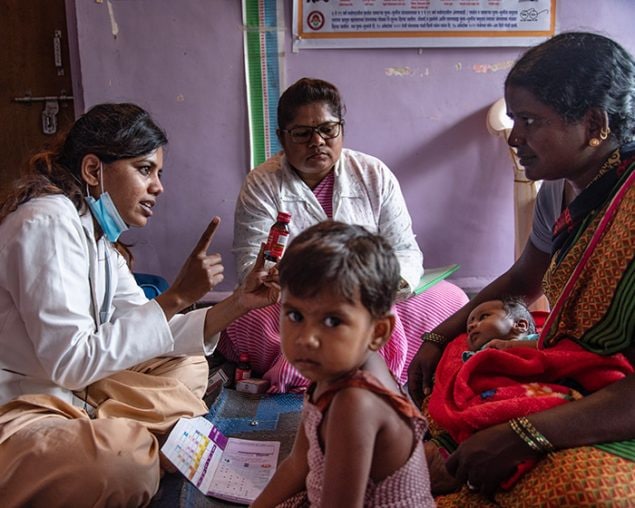Why CDC Is Involved in Global Immunization
Updated April 20, 2023
Immunization is a Best Buy for Public Health
Immunization is a sound investment and is among the most cost-effective ways to improve health, and by extension, strengthen national, regional, and global health security.
Immunization Saves Lives

A healthcare worker makes a home visit to vaccinate children in India. ©UNICEF/U.S.CDC/UN0735377/Khemka
Childhood vaccinations prevent an estimated 4 million deaths worldwide every year.
Despite having safe and effective vaccines to prevent and protect against many known deadly and disabling diseases, vaccine-preventable diseases (VPD) remain a leading childhood killer and global health threat. Why? Because about 1 in 5 children in the world do not have access to the life-saving immunizations that help protect children and their families from dangerous vaccine-preventable diseases.
Vaccines can effectively improve health and well-being throughout the life course. In addition to immunizations that children receive through essential immunization services, important protection is provided through vaccines in adolescents against HPV and meningitis. Adult populations can also continue to benefit from immunizations, including among higher risk groups, such as health workers and displaced communities. Vaccines are used for outbreak-prone diseases, such as typhoid, cholera, Ebola, and yellow fever, to protect whole communities across age groups. In many countries, immunization services play a vital role as an entry point into primary healthcare.
By preventing the spread of VPDs, immunization programs save lives and prevent disease and disabilities, as well as help:
- Prevent vaccine-preventable disease outbreaks, thereby reducing the hardship of vaccine-preventable loss of life, health, safety, and livelihood, as well as avoiding the community disruption outbreaks may cause
- Strengthen global health security, including decreasing antibiotic resistance (due to reduced use of antibiotics) and economic instability
- Help countries sustainably prevent, detect, and respond to VPDs, as well as other emerging disease threats
Immunization is Cost Effective
Vaccine-preventable diseases create costs for families, communities, businesses, and health systems. Immunization is among the most cost-effective ways to support a healthier and safer world. In low- and middle-income countries, the return on investment from immunization programs has been estimated at $52 per $1 invested when considering the broader social and economic costs avoided because of vaccination.
For example, by immunizing and preventing disease, we reduce the risk of financial hardships and economic instability by avoiding:
- Lost work and school days
- Cost of medical care
- Diversion of resources to outbreak response
- Outbreak-related disruptions to local and global economies, travel, and trade
Immunization Makes a Healthier and Safer World

Boys cluster around this truck delivering CDC assistance in the field.
In addition to protecting people from disease, vaccination also helps keep those diseases from spreading when people interact with others and their environment. Immunization:
- Improves life expectancy for children and promotes a healthy start in life
- Provides protection from preventable diseases throughout the lifespan, including protection for at-risk populations due to occupation, displacement, or migration
- Supports a healthy and productive workforce in local and the global economies
- Advances safety and security for Americans where they live, work, and play
Immunization is a Foundation for Primary Care
When people visit healthcare providers for vaccinations, it is an opportunity to check on their overall health and provide other health services that they or their family members may need, preventing or reducing individual and community health risks.
Modeling the impact of vaccination for the immunization agenda 2030: Deaths averted due to vaccination against 14 pathogens in 194 countries from 2021-2030.
Carter A, Msemburi W, Sim SY, A.M. Gaythorpe K, Lindstrand A, Hutubessy RCW. SSRN Electronic Journal. April 2021. doi: 10.2139/ssrn.3830781.
Return on investment from immunization against 10 pathogens in 94 low- and middle-income countries, 2011–30.
Sim SY, Watts E, Constenla D, Brenzel L, Patenaude BN. Health Affairs. 2020;39(8):1343-1353. doi: 10.1377/hlthaff.2020.00103.